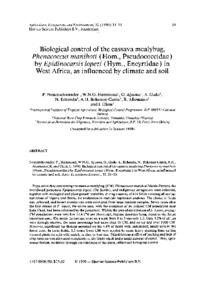| dc.contributor.author | Neuenschwander, P. |
| dc.contributor.author | Hammond, W. |
| dc.contributor.author | Ajuonu, O. |
| dc.contributor.author | Gado, A. |
| dc.contributor.author | Echendu, N. |
| dc.contributor.author | Bokonon-Ganta, A. |
| dc.contributor.author | Allomasso, R. |
| dc.contributor.author | Okon, I. |
| dc.date.accessioned | 2022-07-20T12:44:33Z |
| dc.date.available | 2022-07-20T12:44:33Z |
| dc.date.issued | 1990 |
| dc.identifier.citation | Neuenschwander, P., Hammond, W., Ajuonu, O., Gado, A., Echendu, N., Bokonon-Ganta, A., … & Okon, I. (1990). Biological control of the cassava mealybug, Phenacoccus manihoti (Hom., Pseudococcidae) by Epidinocarsis lopezi (Hym., Encyrtidae) in West Africa, as influenced by climate and soil. Agriculture, Ecosystems and Environment, 32(1-2), 39-55. |
| dc.identifier.issn | 0167-8809 |
| dc.identifier.uri | https://hdl.handle.net/20.500.12478/7556 |
| dc.description.abstract | Population data concerning the cassava mealybug (CM) Phenacoccus manihoti Matile-Ferrero, the introduced parasitoid Epidinocarsis lopezi (De Santis), and indigenous antagonists were collected, together with ecological and plant growth variables, during a survey of 414 fields covering all ecological zones of Nigeria and Benin, for evaluation in multiple regression analyses. The choice of fields was unbiased, and insect populations were estimated from large random samples. Seven years after the first release of E. lopezi, the entire area, with the exception of an isolated CM population near Lake Chad, had been colonized by the parasitoid. Within the area of distribution of E. lopezi, average CM populations were very low (1.6 CM per shoot tip), highest densities being found in the forest transition zone. The mean tip damage score on a scale from 1 to 5 was only 1.2. Only 3.2% of all tips were strongly stunted, the same percentage had more than 10 CM, and no tip had over 1000 CM. However, significant tip damage persisted on the 4.8% of fileds with unmulched, sandy soils in the forest zone. In these fields, 3.3 times fewer CM were needed to cause heavy stunting than on less stressed plants on soils with mulch, or clay, or less rain. This deleterious effect of leaching and lack of crop rotation was alleviated completely in the fields which had a small amount of mulch. Thus, agronomic factors, mediated through the condition of the plant, influenced biological control. |
| dc.format.extent | 39-55 |
| dc.language.iso | en |
| dc.subject | Cassava |
| dc.subject | Mealybugs |
| dc.subject | Biological Control |
| dc.subject | Phenacoccus Manihoti |
| dc.subject | Parasitoids |
| dc.title | Biological control of the cassava mealybug Phenacoccus manihoti (Hom., Pseudococcidae) by Epidinocarsis lopezi (De Santis) (Hym., Encyrtidae) in West Africa, as influenced by climate and soil |
| dc.type | Journal Article |
| cg.contributor.crp | Roots, Tubers and Bananas |
| cg.contributor.affiliation | International Institute of Tropical Agriculture |
| cg.contributor.affiliation | National Root Crops Research Institute, Nigeria |
| cg.contributor.affiliation | Service de la Protection des Végétaux, Direction de l'Agriculture, Benin |
| cg.coverage.region | Africa |
| cg.coverage.region | West Africa |
| cg.coverage.country | Benin (Dahomey) |
| cg.coverage.country | Nigeria |
| cg.coverage.hub | Headquarters and Western Africa Hub |
| cg.researchtheme | Plant Production and Health |
| cg.identifier.bibtexciteid | NEUENSCHWANDER:1990a |
| cg.isijournal | ISI Journal |
| cg.authorship.types | CGIAR and developing country institute |
| cg.iitasubject | Cassava |
| cg.iitasubject | Disease Control |
| cg.iitasubject | Pests of Plants |
| cg.iitasubject | Plant Breeding |
| cg.iitasubject | Plant Diseases |
| cg.iitasubject | Plant Health |
| cg.iitasubject | Plant Production |
| cg.journal | Agriculture, Ecosystems and Environment |
| cg.notes | Published online: 07 Jul 2003 |
| cg.accessibilitystatus | Limited Access |
| cg.reviewstatus | Peer Review |
| cg.usagerightslicense | Copyrighted; all rights reserved |
| cg.targetaudience | Scientists |
| cg.identifier.doi | https://dx.doi.org/10.1016/0167-8809(90)90122-T |
| cg.iitaauthor.identifier | Peter NEUENSCHWANDER: 0000-0003-0580-0376 |
| cg.futureupdate.required | No |

